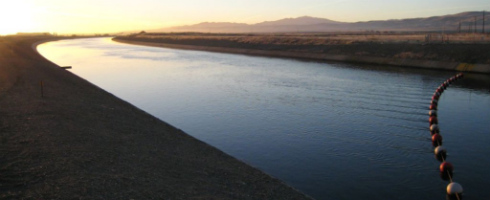Paying for California water action plan beyond the drought
 California Aqueduct. (Photo Credit: sfbaywalk/flickr)
California Aqueduct. (Photo Credit: sfbaywalk/flickr)
Released today, Governor Jerry Brown’s final version of a five-year “Water Action Plan” lays out something most people involved in the contentious water issue can agree on: finding new, smart ways to navigate the choppy waters of long-term financing is vital to the California economy.
While the twin Delta tunnels and the possible $6-8 billion water bond got the bulk of the water press last year, the newly-official drought has been a stark reminder that there are a lot of moving parts to the state’s water network that need attention.
The governor’s Action Plan highlights the $619 million for water projects contained in his proposed 2014-15 budget and also lays out a focus for the next five years. If the drought challenges we face now are the “new normal,” we could be in for a bumpy ride without a strong, integrated strategy.
The San Jose Mercury News looked into the crystal ball to scry the economic effects of a “megadrought” that drags on for several years. Experts told them that California’s water system has not been exposed to such a drought. The dangers to the economy are extrapolated out to include farmers’ loss of water, a huge loss of row crops, increased pumping of groundwater to keep orchards alive, and food prices going up, among other effects. Yet, the story reminds us that conservation efforts, like ones in effect in Australia, could help pull large cities through a megadrought.
But in the long-term, with water systems created for a population size long surpassed, California needs more than short-term drought mitigation.
“We need regulators to rebalance water rules and enable voluntary transfers of water and we must prepare for forest fires,” said Brown, in his State of the State speech last week. “As the State Water Action Plan lays out, water recycling, expanded storage and serious groundwater management must all be part of the mix.”
The Water Action Plan also includes flood protection and regulatory efficiency proposals. The final section gets into how to pay for long-term upgrades. It’s a daunting task: Current conservative estimates show that California needs almost $30 billion, just to pay for new and upgraded wastewater treatment facilities alone.
The “Develop Water Financing Strategy” bullet point in the governor’s plan at this stage only identifies potential sources “including cap and trade auction revenue under AB 32, energy efficiency funds, user and beneficiary fees, polluter fees, local measures, and other sources and will establish principles to guide the use of these funding sources.”
But it’s another important intersection with the Summit’s own emerging prosperity strategy for the state, when it comes to the state’s infrastructure.
The expanded use of new financing tools, not just in water projects, but many of the state’s aging transportation systems, will help the state advance important projects all over the state without breaking the bank.
Just one example comes from a former Infrastructure Bank director, Stan Hazelroth, who laid out for us how using leverage to multiply funding available without adding new liabilities to the state budget was possible.
And there were promising signs last year coming from the capital during the discussion about the proposed water bond, including a focus on results-based planning, integrated efforts and finding new ways to pay for needed infrastructure projects.
Drought or no drought, the way forward includes thinking beyond the crisis and putting a strategy in place to help the state and economy change the way we do business. And hundreds of Californians came together at the 2013 Summit, forging hundreds of commitments to make sure issues like crumbling infrastructure don’t get in the way of job creation and the California’s ability to compete in the global economy.
Originally published on CAeconomy.org.

Dr. Ansari on health care’s future amid demographic shifts
Original story on permanente.org During a recent CEO workgroup panel, “Advancing Your Culture…
December 23, 2024
Drs. Hoberman and Nguyen on preparing for health care AI
Original story on permanente.org Many questions surround the advancements of artificial intelligence in…
October 30, 2024